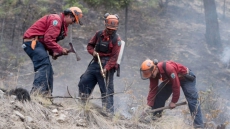TORONTO — Critics say the Ontario government should pay the bill when patients are forced to take air or ground ambulances because their local hospital doesn't offer the service or treatment they need.
The Liberals made a deliberate decision to allow only certain hospitals to offer services such as neo-natal or cardiac care, which forces patients in northern Ontario to travel great distances, said New Democrat health critic France Gelinas.
Hospitals in northern and rural Ontario are "shells of what they used to be," and offer very little in the way of actual services for many patients, said Gelinas.
"They stabilize you long enough for Ornge (air ambulance service) to ship you out," she said. "This has become our hospital service in northern Ontario, and hospital services are covered by medicare and should be covered by the government."
The recent case of an Alberta woman hit with a huge bill for an Ornge air-ambulance ride from Timmins to Sudbury highlights the problem, said Gelinas. Staff at the Timmins hospital advised Amy Savill to fly to Sudbury because they were unable to care for her safely after she went into labour prematurely.
"Timmins should have had a neo-natal unit to handle the needs of her newborn baby," said Gelinas.
Ornge could not comment on a specific case, but said a one-hour flight on a helicopter ambulance would cost between $8,000 and $10,000.
The Progressive Conservatives said the government should pay the tab because its policy forces patients to fly to distant hospitals.
"They should have allocated for these types of situations to arise," said PC critic Bill Walker. "Ten thousand dollars would cripple most people."
The Ontario Council of Hospital Unions said Savill's air-ambulance ride was a direct result of the Liberal government's "aggressive" downsizing of obstetric services.
"No Canadian should be forced to personally bear the cost of a deliberate policy of centralization of birthing services," said union president Michael Hurley.
The Liberals turned some hospitals into "centres of excellence" that specialize in services no longer offered by hospitals in other communities, said Gelinas. Hospital and physician services are supposed to be free to all Canadians, she added.
"You've changed the model in Ontario to fly everybody, so the transportation costs becomes part of that and should be covered by medicare," said Gelinas. "This is now part of medically necessary hospital services."
The Ministry of Health said funding was not the issue in Savill's case because the Timmins and District hospital never had a level 2/3 neonatal intensive care unit that was needed to deliver and care for her premature baby.
"The suggestion that Timmins could have done this before any alleged cuts is simply inaccurate," the ministry said in a statement.
Ontario residents with a valid OHIP card pay $45 for an ambulance as long as a doctor deems it medically necessary, but if not, it's a $240 co-payment for each land ambulance service — or the actual cost of each air ambulance trip.
Out of province residents also pay the actual cost of an air ambulance unless its between two Ontario hospitals and they return to the first one within 24 hours.
The Ministry of Health always recommends Ontario residents buy private travel insurance when leaving the province, even when staying within Canada.
The Canadian Automobile Association says insurance would help in emergencies with the costs of such things as drugs, laboratory and diagnostic services outside of hospitals as well as with devices such as crutches and prosthetics.
But the Travel Health Insurance Association cautions coverage "would be subject to insurance policy wording and exclusions, such as premature birth and pre-existing condition clauses."
Health Minister Eric Hoskins said coverage of air ambulance services for patients travelling outside their home province is something he will raise with his counterparts across the country.






